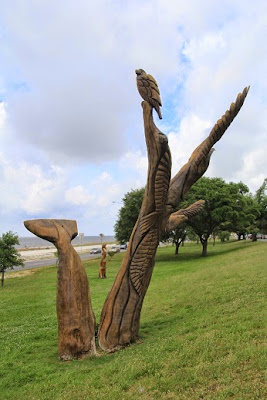We continue heading west on Beach Boulevard in Biloxi with stops along the way to photograph some homes and some more of the tree sculptures.
The contributions of Dayton Scoggins' initial carvings (shown in yesterday's entry) "...inspired Fort Walton Beach, Florida, sculptor and frequent Biloxi visitor Marlin Miller to approach the city about donating his time and talent to sculpting more of the standing dead trees.
"The majority of the 20 sculptures along the Boulevard are Miller's. According to city of Biloxi officials, Miller wanted to leave his mark on Biloxi and return the favor of Biloxians who had helped his community recover after Hurricane Ivan several years earlier.
"In an American Profile article, Miller said, 'Most generations in Mississippi go eight or nine generations deep, he explains. When these people lost a giant tree, it wasn’t just theirs. It was something that their great-great-great grandparents played under as children. This token gesture from me represents a rebuilding of the spirit.
"During his initial two days of work (in mid-December, 2007), Miller sculpted four trees, creating a dolphin, egrets and a seahorse.
"In his second trip one week later, Marlin created an egret, a dolphin and a pelican, and, on a third trip, again one week later,...Marlin created sculptures of two sailfish" (biloxi.ms.us/katrina-biloxi/sculptures/)..
By the end of April, 2008, Marlin, also known as "Mad Marlin," had donated about three-fourths of the twenty tree sculptures along Beach Boulevard.
In an article in American Profile (August 26, 2010), Sharon H. Fitzgerald writes about Marlin Miller and his work:
"Ravaged in August 2005 by Hurricane Katrina, the coastline is dotted with fallen trees that once were towering cedars and centuries-old live oaks. The stark trunks that remain are grim reminders of Katrina’s wrath, but to Miller, 49, they are blank canvases. Since 2007, he has transformed nearly 50 tree trunks into dramatic carvings of coastal marine life and, in the process, transformed the spirits of Mississippians.
“'What I have gotten out of this ride has just been incredible,' says Miller, who donated his time and talents to create an outdoor gallery along a 25-mile stretch of U.S. Highway 90. 'It hasn’t been about money.'
"While he works, Miller frequently is approached by coastal residents who offer their thanks on behalf of their communities. Their words often dissolve into tears, however, while trying to describe what the sculptures represent to a region working to rebuild. 'The emotion, it’s still so strong here, and then I get all emotional, too,' Miller confides.
"Some strangers try to give him money to help pay his expenses, but when Miller refuses to accept cash, he ends up with gifts of homemade jellies, ceramics, Christmas cards and even a prayer shawl. 'I do all this for free,' he says. 'I don’t want to mess with the integrity of this project.'
"'The project’s purpose,' he says, 'is to give back to the people of Mississippi during a time of need....
"Raised on a family farm in Manson, Iowa (pop. 1,893), Miller is a fourth-generation artist. His grandfather painted wildlife scenes, as well as most of the business signs in their county. Miller was introduced to the Gulf Coast while stationed in the early 1980s at Keesler Air Force Base in Biloxi. There, he developed his love of the sea and, after military service that took him to Hawaii, Europe and the Middle East, settled in Fort Walton Beach.
"Miller’s carvings capture his love of marine life, and his works are on display in galleries, restaurants and the homes of private collectors around the world. In recent years, however, his passion has been to salvage hurricane-whipped trees tagged for removal. Nearly every week, Miller and his truck, loaded with chain saws, grinders, chisels and wooden mallets, have made the three-hour drive from his home to Biloxi to carve for a few days. Occasionally, the truck tows a hydraulic lift to hoist Miller to the top of the trunks, some of which tower three stories high.
“'What Marlin has done for this community is just a godsend,' says city spokesman Vincent Creel. 'It’s a gift that’s going to give for generations.'
"Visitors to Biloxi rank Miller’s sculptures as the city’s top tourist attraction.
The White House Hotel
Biloxi Water Department
“'We recover, we replant, and we renew, but not everything that passed out of life should be cut down and moved on,' Dickinson says. 'Let’s celebrate what’s been left inside those majestic trees that have been here for so very long.'
"For Miller, his Katrina tree project has been a surprising journey that began with a single carving in Biloxi and kept drawing him back. 'I’m along for the ride,' says the artist, his eyes welling with tears. 'I have been driven by something much bigger than me'” (americanprofile.com/articles/sculptor-carves-hurricane-katrina-ruins).
"Woody"
Sculpture by Marlin Miller, named in honor of Woody Bailey
Mississippi Coast Coliseum and Convention Center
.JPG)
.JPG)
.JPG)
.JPG)

.JPG)
.JPG)
.JPG)
.JPG)
.JPG)
.JPG)
.JPG)
.JPG)
.JPG)
.JPG)
.JPG)
.JPG)
.JPG)

A very cool story that I was totally unaware of.
ReplyDelete